
|   |

|   |
Dance India Asia Pacific Festival, Singapore - Dr. Sunil Kothari e-mail: sunilkothari1933@gmail.com Photos courtesy: Apsaras Arts October 6, 2012 When I learnt that Dance India from Milapfest in UK was becoming a part of Dance India Asia Pacific, and I was to visit Singapore on my way to Kuala Lumpur, I decided to stop over in Singapore for three nights before going to attend Ramli Ibrahim's Tarikan Dance Festival on 2nd September onwards. I am glad I decided to do so, as Guru Neila Satyalingam, the former Kalakshetra alumnus and a pioneer Bharatanatyam dancer, director of Apsaras Arts, who has trained a generation of dancers in Singapore, was a partner of Milapfest for this unique collaboration and bringing top dancers to give workshops and perform for young Singapore dancers. My dynamic friend Aravinth Kumarasamy, a versatile musician, veena player, music composer, nattuvangam artiste and classical dancer, closely associated with Apsaras Arts, welcomed me and arranged for my talk on my writing books on Indian classical dance, at Goodman Arts Centre on 1st September 2012.
I was very keen to catch up with performances by Leela Samson, Aditi Mangaldas, Shanta Rati Mishra and Arushi Mudgal at Esplanade Theatre studio. It is a fantastic cultural centre, sharing many common features with Barbican Centre in London and Brooklyn Academy of Music (BAM) in New York. I had missed out on performances at this venue. The last time I saw Leela Samson's Bharatanatyam was two years ago when India International Centre in Delhi celebrated its IIC Experience when Leela performed accompanied on music by Bombay Jayashree and Priyadarsini Govind accompanied by TM Krishna . I was keen to see Leela Samson's solo which I got an opportunity to witness here at Esplanade Studio Theatre. She chose three numbers, two abhinaya pieces Mahakaleswarashtakam and Ardhanarishwara dedicated to Lord Shiva and one tillana. There was great repose in what she performed. Minus all the bravura and speed, her leisurely exposition of Mahakaleswarashtakam was a tour de force, bringing to the notice of cognoscenti audience her internalized understanding of Bharatanatyam at her alma mater Kalakshetra. She transcended the technique and performed with ease the numbers which left an indelible impression. Bharatanatyam has undergone several changes. But in her case the presentation was full of underplay, quiet, unhurried and communicative. She did not have to prove anything and danced as she does with complete conviction. Today's young generation could learn from her presentation why peaceful, unhurried and yet without losing the complexities of Bharatanatyam form her performance uplifted one from the mundane existence. Why we call vishranti, repose, adds another dimension to Bharatanatyam. Well versed in Kalakshetra technique she transcends the technique and one sees the authority imbued with dignity. No cascades of teermanams, no dancing in druta, fast tempo and yet evoking images of unparalleled beauty, the Bharatanatyam form acquires a dimension so refreshing. The iconic images of Lord Shiva in both compositions were rich and evocative. The postures conveying lasya of Parvati and masculine vigour of Lord Shiva came through with simplicity. One is familiar with Sankaracharya's Ardhanariswara composition. This one by Guru Guha is different and is replete with references to various aspects of Lord Shiva. His trinetra opening, in matted locks Ganga is captured, the ornaments of Parvati and of Lord Shiva, the aharya, the necklaces, in one case of serpents in case of Parvati's jewels, and the evocation of Namah Shivaya leading all, tuned to her dancing, to a mood of prayer, were delectable. I have seen lot of Bharatanatyam in my long career as a dance critic and I felt fortunate to witness Leela's approach, maturity, subtlety of expressions, unhurried nritta which lifted audience to another plane. She chose numbers which became her age and looked appropriate. One can learn a lot about how to dance when one advances in age and enriches one's self with realization, reflection, which adds to the enjoyment of the form. And an over all humility which permeated throughout made one realize that a dancer performs with integrity and understating of higher values. In tillana also she performed with same ease. No flashy movements, no jazzing up the presentation, and executing movements which had simplicity and thorough grounding in the technique. The periya adavus when she performed covering the stage had enchanting quality. The text in praise of Muruga was full of devotion. The finale in an arresting pose, with circular spotlight on her brought down the house. The audience gave her a standing ovation. 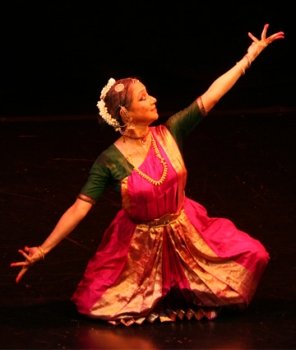 Leela Samson 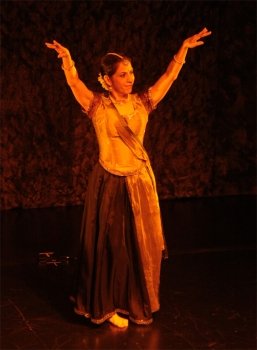 Aditi Mangaldas Prior to her Aditi Mangaldas presented three choice Kathak numbers, choreographed by her, in a flawless manner. The one in which she danced to rendering of Meera composition rendered by Shamiullah Khan from 'Uncharted seas' choreographic work, had all the richness of Kathak technique, nritta elements, speed, breathtaking pirouettes, chakkars ,and vachikabhinaya, oral rendering by her about Krishna, love, devotion, the meeting of the eyes, the decorations of ornaments of Krishna - without resorting to image of Krishna holding the flute, she suggested his standing under Kadamb tree and her yearning for him. The intensity coupled with her energetic dancing revealed the quality of Kathak, its unexplored areas, and in the finale when she performed tatkar with tintinnabulation of ankle bells, she mesmerized the audience with exquisite lighting by light designer Narayan Chauhan. Light also played role in another composition, Winter. With back to audience in near white diaphanous costume, in diagonal lighting across the stage, she negotiated her movements in an unusual manner with silences. Her entire frame spoke and if the snowflakes were seen falling it was a miracle. The Kathak vocabulary has been explored by her from various angles and speaks volumes for her search and innovations. Collaboration with musicians and light designers has made her performances a notch above her contemporaries. A lot of thinking goes behind what she does. An excerpt from Timeless, a larger choreographic work looked novel. Shubha Mudgal's singing added extra dimension. The beloved's touch and the swing which song spoke about was a mere peg for her to perform with intensity which had a deep appeal. There was no literal translation of the libretto, nor did she suggest a swing, but she showed artistically how she was united with the beloved with her arms encompassing her frame. Each pore of her body sought the beloved. And that evocation was intense. It was conveyed through the vocabulary which enriches Kathak and gives Aditi her own identity. Groomed by her guru Kumudini Lakhia and later on Pandit Birju Maharaj, Aditi after yeas of thorough training has, since last decade, ventured into excellent choreographic works, dovetailing light designer and musicians who have been working with Akram Khan. Aditi has created her own niche in Kathak equally sound in contemporary and traditional Kathak. The evening had contrast of two classical dance forms. Whereas Aditi's Kathak was replete with energy, speed, innovations, Leela Samson's Bharatanatyam had, as observed earlier, a quality of repose and leisurely exposition. Versatile artistes of high caliber, both gave aesthetic delight. Next day, Arushi Mudgal, niece of Madhavi Mudgal, presented Odissi. She is trained by Madhavi Mudgal in Odissi from a very young age and is brought up in an atmosphere where music and dance are round the clock. Her grandfather Vinaychandra Mudgal and grandmother were well known musicians. Under her father Madhup Mudgal, the musician, Arushi has studied classical vocal Hindustani music also. She has now blossomed into a fine Odissi exponent with a commendable repertoire. After a wide exposure both within India and abroad, Arushi displayed with confidence her technical finesse of Odissi. She introduced the dance numbers briefly and performed with Úlan and vivacity. Noteworthy was Guru Kelucharan Mohapatra's choreographed Kha champu, where every stanza begins with the alphabet Kha. The sakhi tells Radha that "you are mad to fall in love with Krishna, who has conquered the Kaliya serpent. You are not like one who shall be able to control Krishna, like a serpent catcher playing instrument captures the serpent. You silly girl, do you know you are playing with a sword and not being an expert shall only hurt yourself. Believe me, do not fall prey to Krishna's charm." With quicksilver changing expressions registering on face in an effortless manner, Arushi won over the audience. Describing Basant (spring) from Ritusamhara of Kalidasa, she evoked the mood of Basant. Another noteworthy number, her own choreography, was Alhada (joy) to music by her father Madhup Mudgal. She danced with total involvement in a manner which convinced the cognoscenti that Arushi has arrived in her own right as a young competent Odissi exponent. 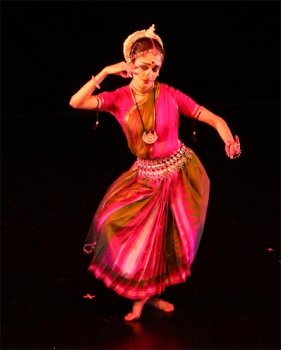 Arushi Mudgal 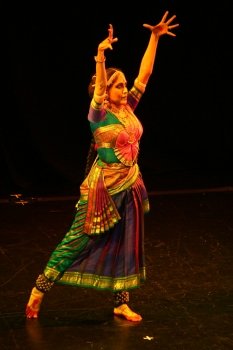 Shanta Rati Mishra For her Kuchipudi exposition, Shanta Rati Mishra, a disciple of Guru Vempati Chinna Satyam, selected patrapravesh daru, the entrance song, choreographed by Vempati for Rukmini Kalyanam dance drama. In the recorded music, he had conducted the nattuvangam. Shanta announced that she was dedicating the number to her late Guru who passed away on 29th July 2012. Rukmini's natural beauty, feeling shy to speak about it, came through in Vempati bani and with flourishes that Vempati has embellished the number with. In a song of Meera, Shanta displayed her histrionics, with an advantage of her former training in Kathakali, impersonating various characters while delineating sanchari bhavas and mythological episodes. Draupadi ki laj raakhi, tum badhayo cheer, Krishna saved Draupadi from humiliation when Dushashana tried to disrobe her in full view of her five husbands and in court; protecting Prahlada when Hirnayakashipu challenged him to show God present in a pillar, bursting out of the pillar as Narasimha, the Lord killed the demon; while frolicking in a pool when the elephant King was caught by a crocodile and he prayed to the Lord to save him, Krishna sent Sudarshan chakra (disc) to kill the crocodile and saved him. When the husband of Meera, the Rana, sent poison to Meera to drink, she drank it and the Lord saved her. Shanta enacted these episodes quite dramatically. The tarangam number, dancing on the rim of a brass plate, won her rounds of applause, as this number is de rigour for any Kuchipudi exponent. Shanta concluded her performance with a tillana. The presenter announced about her as a Singaporean well versed in Kuchipudi and other forms and mentioned about her other achievements like making a film comparing Kathakali dance form with Japanese Noh and Kabuki and Peking Opera. The two day performances offered audiences in Singapore, a glimpse into Bharatanatyam, Kathak, Odissi and Kuchipudi by the dancers whose experience and maturity were seen in their brief recitals. Dance workshops
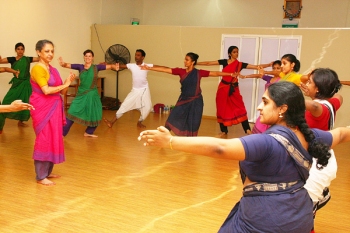 Class by Leela Samson 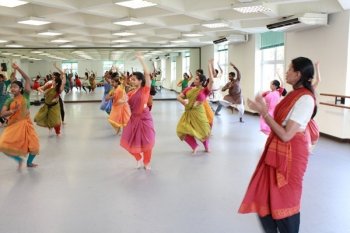 Class by Priyadarsini Govind Besides the performances, for next three days intensive workshops were planned for senior and junior level dancers in Bharatanatyam by Leela Samson and Priyadarsini Govind respectively, at Goodman Art Centre. I could watch Leela Samson's class in the morning. Leela is a teacher of great merit and experience. The explanations she gave for each adavu, basic footwork that dancers execute, the logic behind it, how to hold their bodies, to prevent injuries, correct execution, what part of the body to pull up, how lower back does a huge job taking lot of stress, the spine being strongest part of body, and relevant explanations helped dancers immensely. Such instructions with deep understanding are perhaps missing in present day pedagogy while imparting training. The technical aspects were explained in a lucid manner. I am convinced that today the instructions need to be given in a manner which prepares dancers, making them conscious of their bodies and how to negotiate the movements. Leela's experience over several years was made accessible to the senior dancers in such a workshop. I had to leave for Kuala Lumpur, therefore, I missed her other sessions, which I would have loved to watch. Priyadarsini Govind was teaching a Kavutvam in Tamil. Each word, its significance, meaning, the passages of nritta, pure dance, the way movements were choreographed, and executed bringing out the bani, the style, was an exercise in precision, helping dancers to grasp correctly. The uncluttered movements were emphasized and overall picture while watching dancers perform, gave me an insight into how a senior exponent of caliber of Priyadarsini Govind, imparts and transmits technique. After lunch time, Aravinth Kumarasamy had arranged a conversation with me about how I started writing on dance. He showed my books on Bharatanatyam, Odissi and Kuchipudi to the young dancers and asked me questions about my journey. I spoke about my training in dance, guidance from Mohan Khokar, Dr Mulk Raj Anand and then during formative period, my association with Rukmini Devi at Kalakshetra, reviewing performances with trepidation of Balasaraswati but with courage and humility to ask what I did not follow and learn from them and also mentioned hazards of being a dance critic. Leela Samson drew attention of the young dancers to be aware of the power of money that press barons exercise and the present plight of dance reviews banished from the media. It seems everywhere dance criticism has been reduced to mere reporting in few paragraphs. 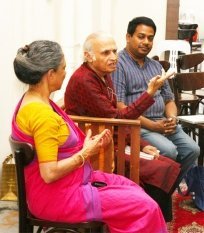 Leela Samson, Dr. Sunil Kothari, Aravinth Kumarasamy 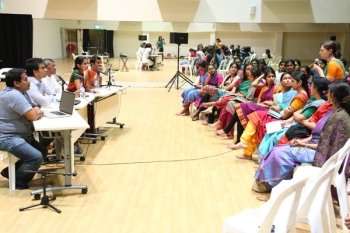 Panel discussion After my talk, Aditi Mangaldas spoke eloquently about Kathak and screened some of the contemporary works, explaining in what directions she was moving in Kathak. Being trained from childhood by Kumudini Lakhia and later on by Pt Birju Maharaj, when she grew up Aditi felt the need for self expression. She has established her own institution Drishtikon and with well trained dancers she has been working for past more than ten years in Kathak exploring movements, using technology, lighting, space, working with musicians like Shubha Mudgal and now with other musicians, getting response for her work from mentors and going ahead, creating her own niche in Kathak nationally and internationally. Before coming to Singapore on previous day in a seminar organized by Rani Khanam for her Aamad institution at India International Centre in New Delhi, I had screened some of the excerpts of Aditi's work and was delighted that at Singapore she screened some of those excerpts and explained her journey. Recently she was invited to Edinburgh Festival with her new work and has received critical appreciation. A local critic, connoisseur asked how come contemporary Kathak is so accessible internationally. Aditi mentioned about Bharatanatyam dance form and Chandralekha's work in Bharatanatyam. She referred to Nrityagram dancers Surupa Sen and Bijayini Satpathy, who have also been performing innovative work in Odissi. On other days, Arushi Mudgal gave workshop in Odissi and Shanta Rati in Kuchipudi, which I missed as I had to leave for Kuala Lumpur to catch up with last two performances of new choreographic works at Sutra Dance Theatre of Ramli Ibrahim. Apsaras Arts and Milapfest deserve congratulations for such high quality performances and workshops, extending boundaries by including Asia Pacific region, making a beginning with Singapore. I am sure they would succeed in coming years and the young generation of dancers in Singapore and those who come from other cities, would benefit a lot.  Dr. Sunil Kothari is a dance historian, scholar, author and a renowned dance critic. He is Vice President of World Dance Alliance Asia Pacific India chapter, based in New Delhi. He is honored by the President of India with Padma Shri, Sangeet Natak Akademi award and Senior Critic Award from Dance Critics Association, NYC. He is a regular contributor to www.narthaki.com, the roving critic for monthly magazine Sruti and is a contributing editor of Nartanam for the past 11 years. Post your comments Pl provide your name and email id along with your comment. All appropriate comments posted with name and email id in the blog will also be featured in the site. |